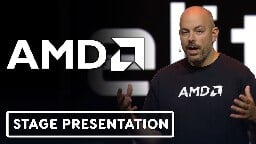FidelityFX Super Resolution 3 (FSR3) - AMD Stage Presentation | gamescom 2023



youtube.com
TL;DW:
-
FSR 3 is frame generation, similar to DLSS 3. It can greatly increase FPS to 2-3x.
-
FSR 3 can run on any GPU, including consoles. They made a point about how it would be dumb to limit it to only the newest generation of cards.
-
Every DX11 & DX12 game can take advantage of this tech via HYPR-RX, which is AMD's software for boosting frames and decreasing latency.
-
Games will start using it by early fall, public launch will be by Q1 2024
It's left to be seen how good or noticeable FSR3 will be, but if it actually runs well I think we can expect tons of games (especially on console) to make use of it.
“Even on consoles” you have my attention. Now to see how good it is
For anyone confused about what this is, it's your tvs motion smoothing feature, but less laggy. It may let 60fps fans on console get their 60fps with only a small drop in resolution or graphical features. But it's yet to be seen.
Looks like there are two versions. One is the one built into the game itself, far more advanced than what your tv can do. The other, supporting all dx11 and dx12 games, is like the soap opera effect from your tv.
I don't think so, there's nothing I can see that suggests that. The only real differences are likely to be to do with lag. There's nothing suggesting a quality difference between if a game has it built in vs you forcing it on a game.
EuroGamer confirmed there is a difference
Then why would any developer ever build it into a game?
It's part of their suite of tools, that includes other things like lag reduction tech. In addition, if your game isn't dx11 or dx12 then you can still provide it to the user. The generic version only works with dx11/12
Also just like nvidia, they pay developers to add these things to games
So, no Vulkan?
I'm not sure, been trying to find the answer. But FSR3 they've stated will continue to be open source and prior versions have supported Vulkan on the developer end. It sounds like this is a solution for using it in games that didn't necessarily integrate it though? So it might be separate. Unclear.
Given that it will eventually be open-source: I hope somebody hooks this to a capture card, to have relatively lag-less motion smoothing for console games locked to 30.
I hate that AMD copied the same terrible branding.
They're just trying to barely hang on to relevance, they're not interested in actually innovating.
AMD has features in yesteryears that it had before Nvidia, its just less people paid attention to them till it became a hot topic after nvidia implemented it.
An example was anti lag, which AMD and Intel implemented before Nvidia
https://www.pcgamesn.com/nvidia/geforce-driver-low-latency-integer-scaling
But people didnt care about it till ULL mode turned into Reflex.
AMD still holds onto Radeon Chill. Which basically keeps the gpu running slower when idling in game when not a lot is happening on the screen..the end result is lower power consumption when AFK, as well as reletivelly lower fan speeds/better acoustics because the gpu doesnt constantly work as hard.
Guys, what would be a better purchase?
Used 6700xt for $200
Used 3060 12GB for $220
Non of the used, get a new $300 card for the 2 years warranty.
Another recommendations.
$200 for the 6700XT is a pretty good deal. It's up to you if you'd prefer getting used or getting something with warranty.
Anybody tried frame generation for VR? Does it work well there, or are the generated frames just out enough to break the illusion?
This is huge. DLSS3 was miles ahead of FSR2. So glad for AMD
DLSS3 and FSR2 do completely different things. DLSS2 is miles ahead of FSR2 in the upscaling space.
AMD currently doesn't have anything that can even be compared to DLSS3. Not until FSR3 releases (next quarter, apparently?) and we can compare AMD's framegen solution to Nvidia's.